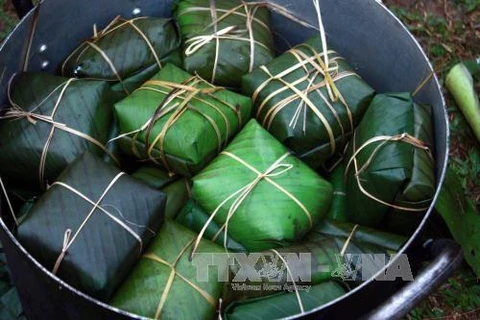Hanoi (VNA) - Tet custom demands different sorts of cake to offer to the earth, heaven and ancestors.
Apart from banh chung (square cake), there are many other delicacies that have become popular over a thousand or more years. They include phu the cake, muot rolls, and sung trau (buffalo horn) cake.
Phu the cake
A well known specialty of Bac Ninh province’s Dinh Bang ward, phu the cake, must be on the Tet offering tray, at wedding parties or other major festivals. When spring comes, the cakes are presented in pairs to present to married couples.
Le Thi Hien, 86, from Dinh Bang, told Viet Nam News that the making of phu the began in the Ly Dynasty in 1009.
People make the popular cake all year round, Hien said, and there are many legends surrounding it. When King Ly Anh Tong went to the warfront, his queen at home missed him so much, she made a cake and sent it to him. The king enjoyed the cake so much and named it phu the (husband and wife) cake.
There is also the story about a trader who had to travel far. His wife made the cake for him to take along, saying that “although far away, my love for you is as sweet as the cake."
Another story: while joining a festival of Do Temple, which falls on 14-15-16 of the third lunar month, King Ly Thanh Tong and his queen had been offered specialty cakes by a Dinh Bang young person. The King and Queen enjoyed the cake so much and named it phu the.
Ever since, the cake has been a sign of faithfulness, so the cake is often present at wedding parties wishing a young couple living to live with each other “until death do us apart”, said Hien.
She said to make a tasty cake, makers use nep cai hoa vang (special fragrant glutinuous rice) ground into powder and mixed with ingredients such as white sugar, green thread papaya and banana oil, vanilla, com flavouring and danh danh (a wild seed) juice all moulded carefully into a dough.
The cake’s interior is filled with green beans, white sugar and coconut juice and thread, Hien said, adding that makers use dong leaves (used to wrap banh chung, square cake) to wrap the cake before steaming it and tying them together in pairs with pink bamboo string. This represents a wish that the couple be tied forever.
Nguyen Thuy Duong from Hanoi said she often travelled to Dinh Bang to buy phu the cakes for Tet. “All my family members, including my grandparents, love the cake."
Muot rolls
Banh muot, something like the famous steam rice roll of Thanh Tri district in Hanoi, carries the special flavours of Nghe An.
Phan Thi Nhan, 72, from Nghe An’s Quynh Doi village, said she remembered when she was a little girl, she and her sisters often waited for their mother returning from the market to bring them with muot rolls which covered with yellow dried onion wrapped in green banana leaves.
The rolls - as long as an adult’s finger - are dipped in a bowl of sauce made from fish sauce, lemon, sugar, and chili. “We often competed to get the rolls because they are so delicious,” said Nhan.
The rolls are made of tam thom (fragrant rice) and are used to offer visitors, for family gatherings, death anniversaries, wedding parties and, of course, Tet. They are often eaten with broth made from steamed beef, chicken or pig’s leg and green bean sprouts, salad and fresh mint herbs from the garden.
Sung trau cake, Co Tu style
For the Co Tu ethnic group, sung trau ( buffalo horn shape) cakes are always be available at Tet. No one forgets to make the cake to worship deities and their ancestors, said Co Tu an elder from Ko Sang.
The Co Tu call the cake Avi cuot, but the name sung trau is more popular and easier to remember.
“The Co Tu place much importance on the buffalo. For example, without a buffalo, a wedding is not perfect, so people make sung trau cake to worship the deity and ancestors at Tet,” Sang said.
To make the cake, people have to use traditional a special glutinous rice known as "proong" and use la dot (wild leaves) to wrap them. The cakes are then tied in pairs soaked in water for two hours before boiling them for another three hours.
The cake is attractive and fragrant. “The cakes ares made without dumpling so it can be kept for a month or more,” said Sang, adding that the cake was used at rice festivals, parties for bumper crops and to welcome visitors.
“I often make them for my grandchildren to take to school or give to my husband who works in the high mountains,” said Sang.-VNA
VNA


























